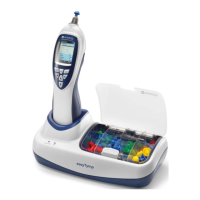5.2.2 Visual Inspection of the Ear Canal
Check the external ear canal for wax with an otoscope. Excessive wax should be removed
by a qualified professional to prevent the probe opening from clogging which will inhibit
testing. Excessive hairs may have to be cut for a seal to be obtained.
5.2.3 Impedance Measurements
Show the probe to the patient and then explain the following:
An ear tip is placed on the tip of the probe and inserted into the ear canal. A seal
must be achieved for the test to progress.
Coughing, talking and swallowing will disturb test results.
The aim of Tympanometry is to test the mobility of the eardrum and the condition
of the middle ear.
A small amount of air will flow through the probe to move the eardrum; it
produces a sensation equal to pressing a finger slightly into the ear canal.
One or more tones will be heard during the test. No participation is expected
from the patient.
The aim of Acoustic Reflexes is to test the condition of the Musculus stapedius.
One or more louder tones will be heard during the test. No participation is
expected from the patient.
5.2.4 Handling the Eartips
Choose the proper size of eartips based on your inspection of the size of the patient’s ear canals.
Insert the probe with ear tip attached into the patient’s ear.
For children and adults, pull gently up and back on the
outer ear (i.e. Pinna) during insertion to straighten the ear
canal. Hold the adapter and aim and twist (gently) the ear
tip into the ear canal. The fit of the ear tip should be
secure; not superficial (Figure 41). Release the earlobe.
When testing infants, gently pull the Pinna down and back
to straighten the ear canal.

